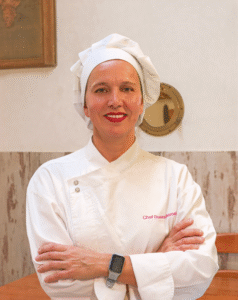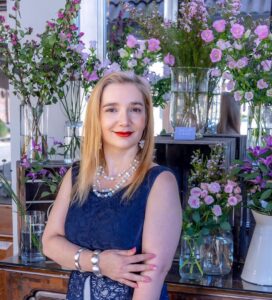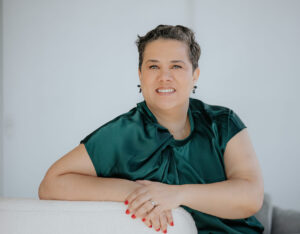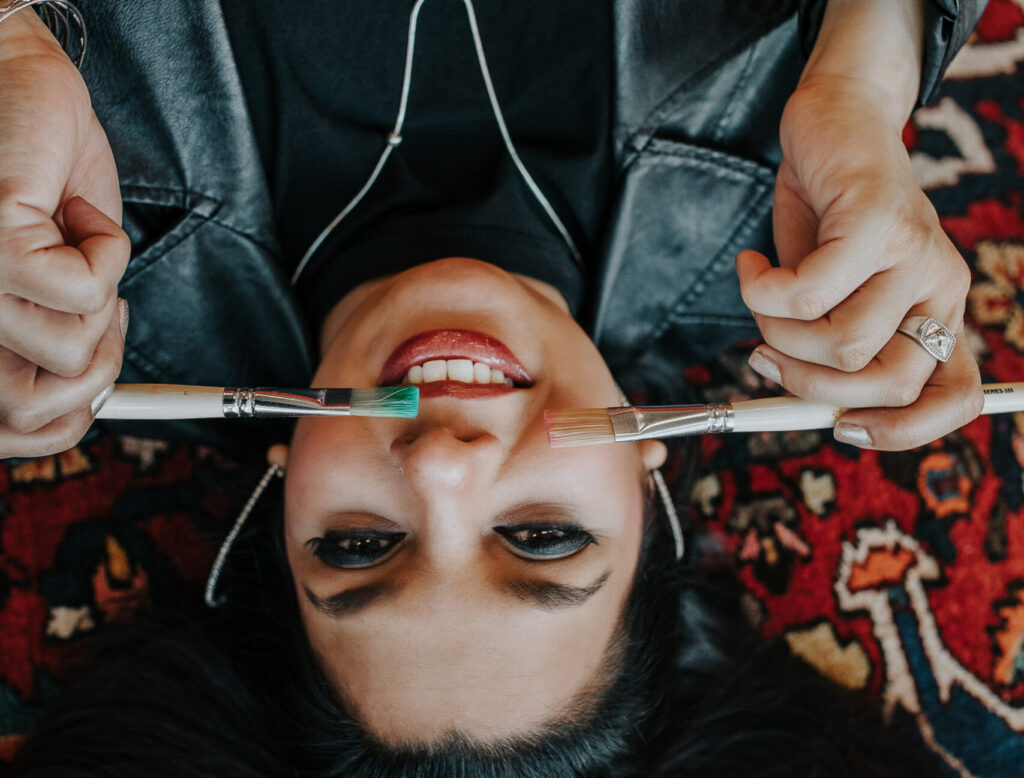
Por: Myllêna Sergel
Em um mundo saturado de ruído e urgência, Amina Art Ansari escolhe falar através do silêncio.
Não um silêncio vazio, mas um silêncio cheio de vida aquele que pulsa em cada pincelada, em cada mistura de cor e em cada olhar retratado em suas telas. Para ela, a arte não é apenas estética: é terapia, é declaração de verdade e, acima de tudo, é uma ponte.
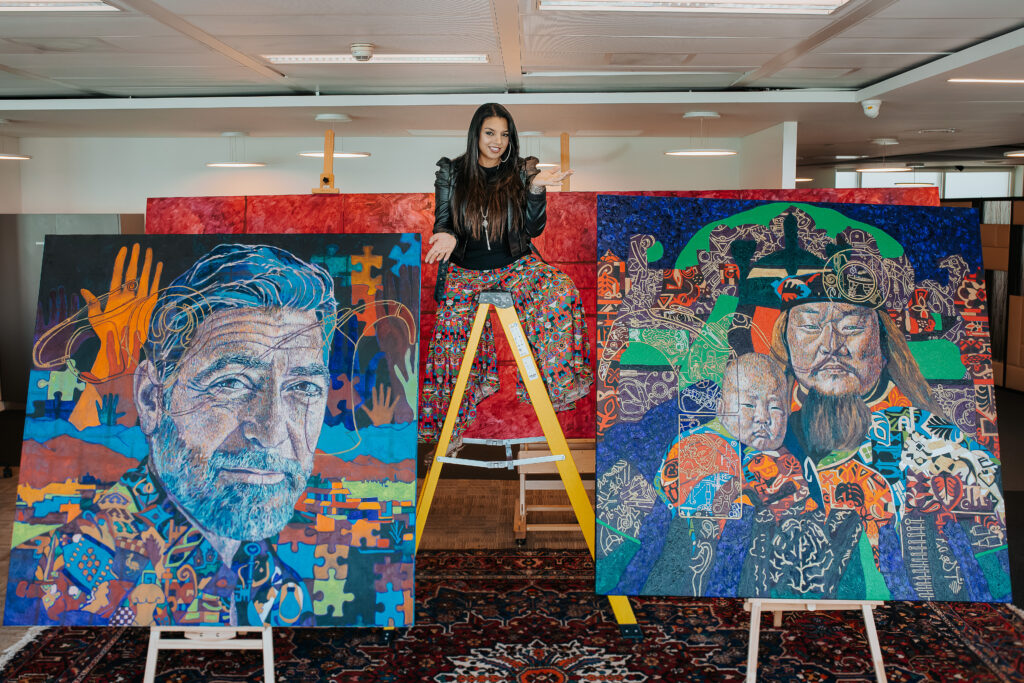
Nascida em Londres, filha de raízes britânicas e paquistanesas, Amina cresceu entre dois mundos culturais e descobriu cedo que não precisava escolher apenas um. “Nunca vi diferença de cor, religião ou origem. Eu via as pessoas como elas eram. Só mais tarde percebi que havia ‘regras’ para descrever o que se vê.” Essa visão crua e honesta, somada a uma vida marcada pelo silêncio da perda auditiva desde o nascimento, moldou seu olhar e a forma como traduz emoções em arte.
A infância foi um tempo de isolamento sonoro, mas de riqueza visual. O silêncio era um espaço seguro onde ela podia criar, longe da pressão escolar e social. “Pinto a alma das pessoas, consciente ou inconscientemente. No início, era a minha fuga das dificuldades e do barulho do mundo. Com o tempo, percebi que minha arte é também meu próprio jeito de ver e sentir a vida.”
Essa perspectiva única se traduziu em uma carreira que atravessa continentes e culturas. Amina já expôs em galerias nos Estados Unidos, Europa e Emirados Árabes. Sua presença também é marcante em oficinas de arteterapia em comunidades vulneráveis do Paquistão a Leicester, no Reino Unido. “Trabalhar com diferentes culturas e contextos me ensinou a ver tanto a beleza quanto as dificuldades em todos os lugares. Isso pinta nossa mente e molda nossa atitude diante da vida.”
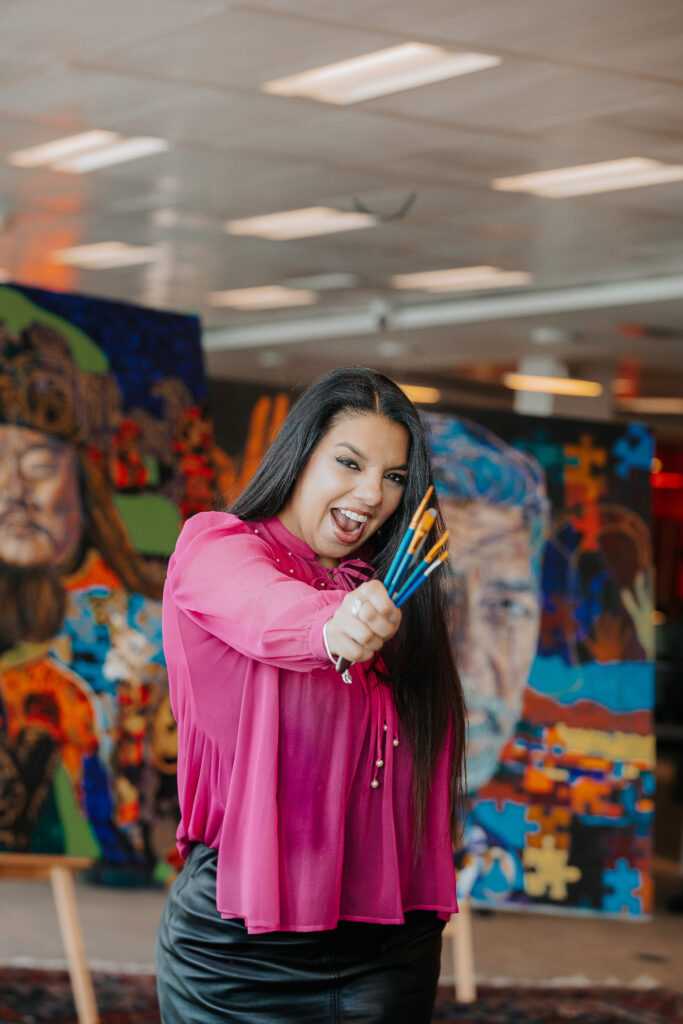
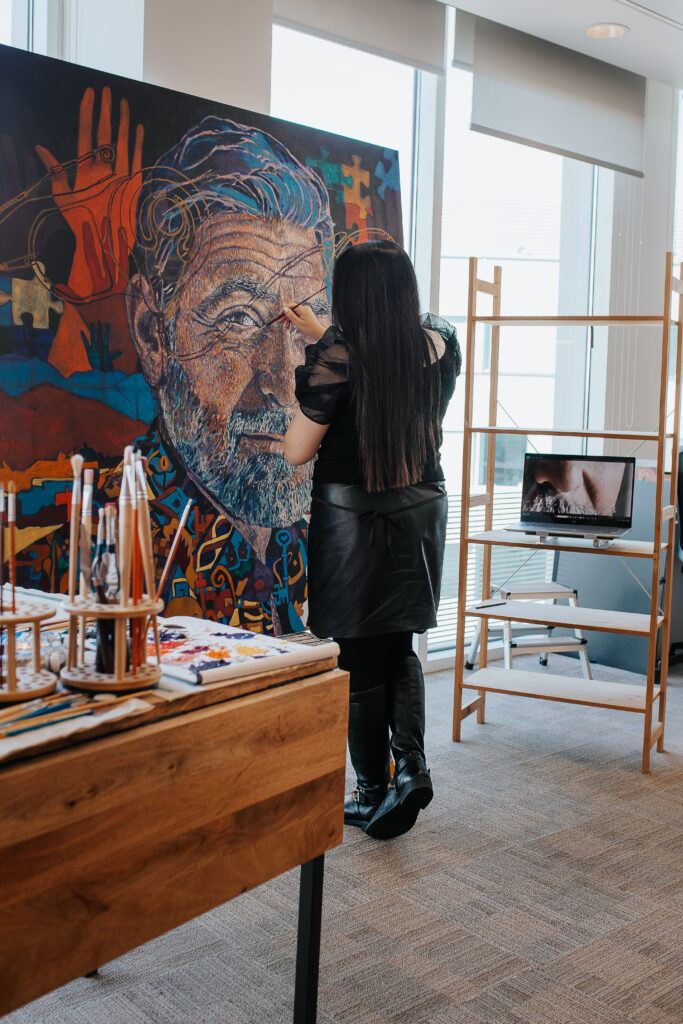
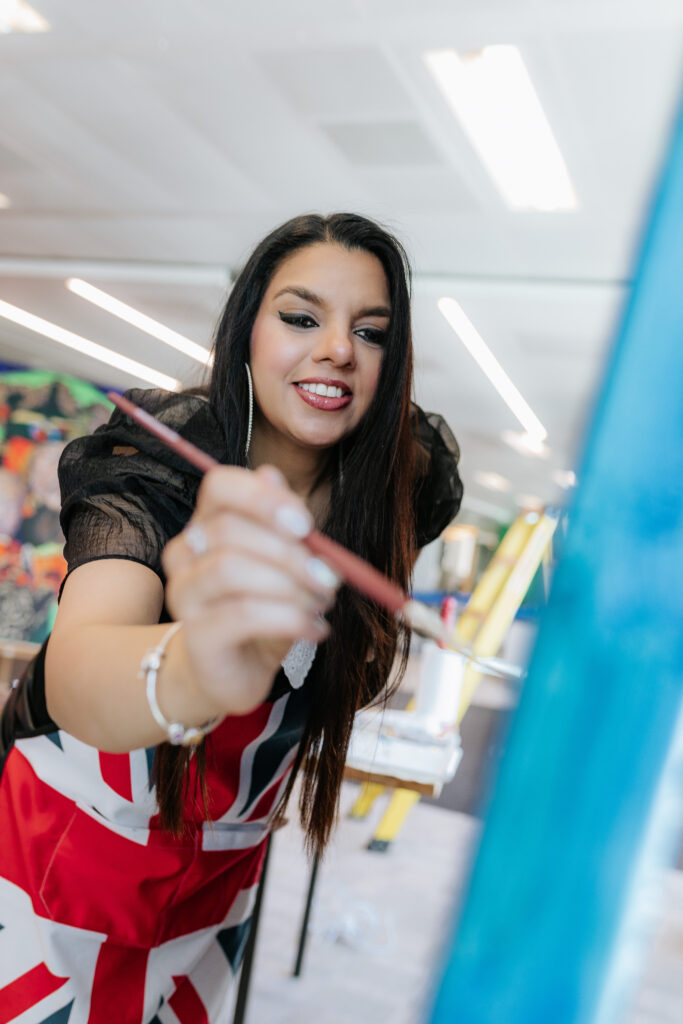
Dois de seus retratos da Rainha Elizabeth II e do Príncipe Philip hoje fazem parte da coleção do Castelo de Windsor. A honra foi acompanhada de um sentimento profundo de pertencimento. “Foi a primeira vez que senti que os britânicos me aceitavam completamente não apenas pela arte, mas pela minha herança e história.” Criar essas obras a partir de imagens já tão conhecidas exigiu um desafio extra: imprimir nelas um toque de expressão única, capaz de ir além da representação fotográfica.
Até pouco tempo atrás, Amina não falava abertamente sobre sua surdez. “As pessoas colocam você em uma caixa. Depois do implante coclear, foi como começar tudo de novo.” A cirurgia marcou um divisor de águas. Sua mãe, presença constante e figura inspiradora, decidiu celebrar a nova fase de forma improvável: um road trip improvisado, de Londres ao sul da França e da Espanha, com Amina ainda em recuperação. “Voltei dessa viagem para ligar o implante e ouvir o mundo pela primeira vez. Isso mudou minha forma de criar agora incorporo sons, frequências e até matemática às minhas pinturas.”
Para ela, um retrato vai muito além do que uma câmera pode captar. “A fotografia depende do instante. No retrato, você é independente. Com camadas de cor, traços e pesquisa, cria sua própria linguagem e identidade.” É essa independência que torna seu trabalho tão característico: combina psicologia das cores, simbolismo cultural e um estilo que transita entre o realismo e o expressionismo.
A espontaneidade é parte essencial de seu processo criativo. “Vem da impaciência e da curiosidade. Pesquiso, estudo, mas deixo espaço para o inesperado. É assim que cresço e crio pontes.” Ela acredita que esse equilíbrio entre técnica e improviso é o que mantém sua arte viva e em constante evolução.
Sua história também é a de uma mulher navegando por universos culturais distintos, muitas vezes opostos. “Na Grã-Bretanha, esperamos o sinal verde para atravessar a rua; no Paquistão, atravessamos no momento certo, mesmo sem regras. Eu gosto de misturar esses mundos e é isso que faço na minha arte.” Essa habilidade de adaptar-se e fundir opostos é a mesma que lhe permite conversar com públicos tão diversos.
Ao retratar figuras como o humanitário Abdul Sattar Edhi e o físico Abdus Salam, Amina sentiu o peso da responsabilidade. “Não existem heróis como eles hoje. Me senti no dever de lembrar o mundo de suas contribuições de celebrar sua força, sua simplicidade e seu impacto.” Para ela, a arte tem esse poder de reavivar legados e provocar reflexão.
Mas nem sempre o caminho foi suave. Amina descreve-se como uma “tomboy” na juventude, mais interessada em esportes e artes marciais do que nas conversas tradicionais. A surdez acrescentava uma camada de isolamento social. “Não saber como fazer networking ou captar informações me tornou autodidata e independente. Isso pode ser positivo ou negativo, mas foi assim que me formei.”
Em paralelo ao trabalho artístico, o compromisso com a arteterapia nunca deixou de crescer. Amina acredita que o ato de criar pode transformar o estado emocional e psicológico de uma pessoa. “O mundo está se invertendo; nossas pequenas ações contam muito. Menos comparação, mais autenticidade. Minhas imperfeições não são arrependimentos, mas ferramentas para me perder e me encontrar na arte.”
Hoje, Amina Art Ansari continua a pintar pontes entre culturas, pessoas e mundos interiores. Sua obra não se limita a paredes de galerias; ela está presente em histórias pessoais, em diálogos entre comunidades e em cada sessão de terapia em que o pincel se torna ferramenta de cura. E, acima de tudo, está ancorada na coragem de se reinventar.
No fim, talvez a maior mensagem de sua trajetória seja esta: a verdadeira arte nasce quando encontramos beleza na imperfeição e construímos, traço a traço, uma ponte entre quem somos e quem podemos ser.
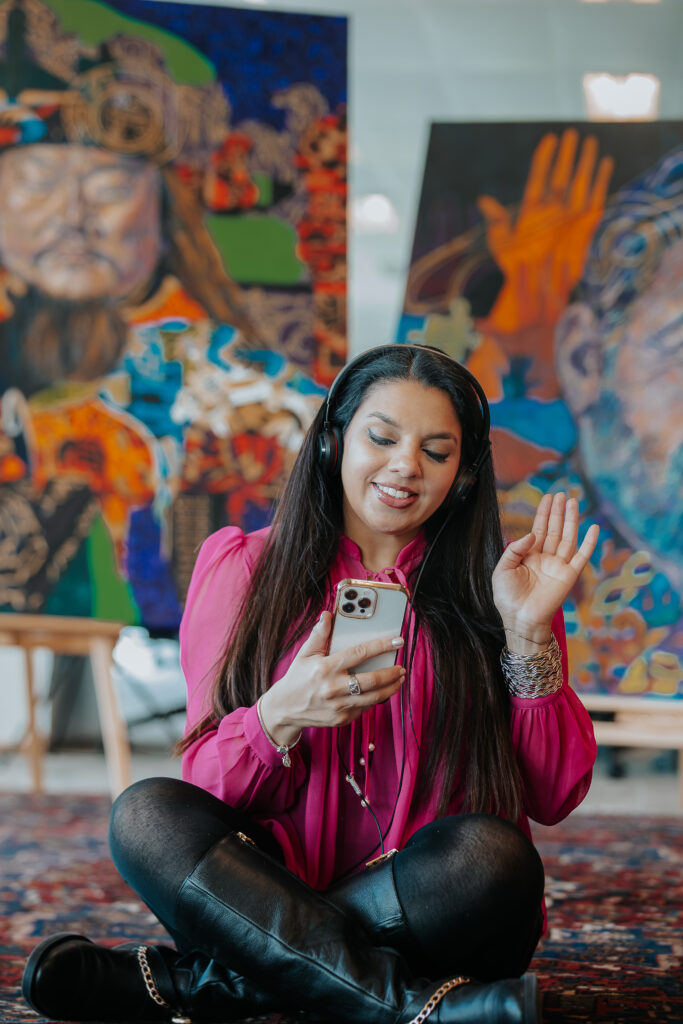
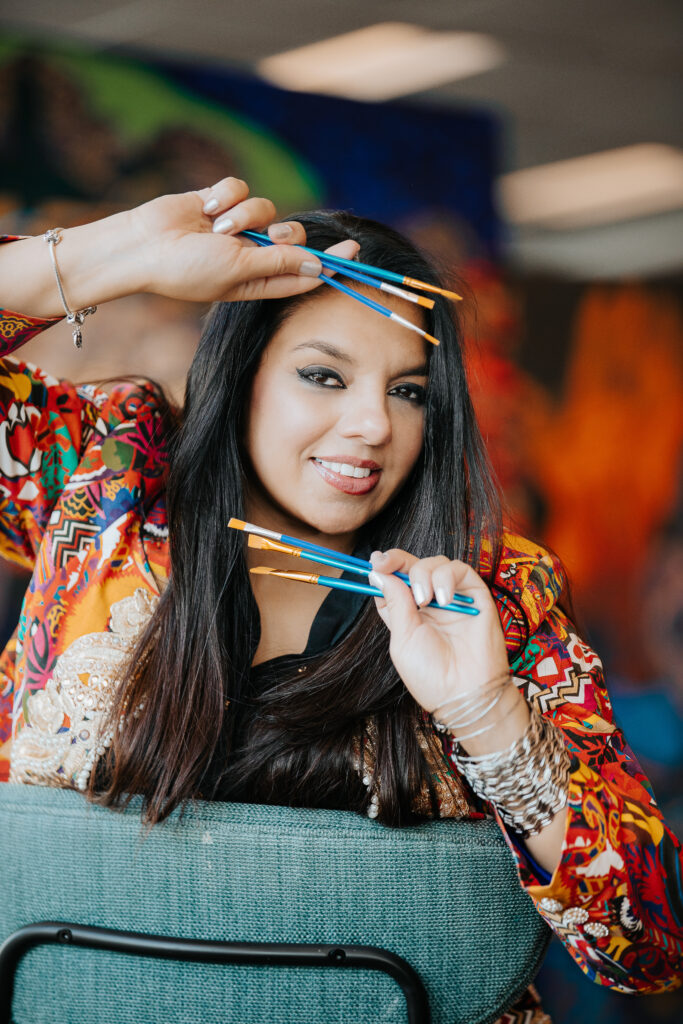
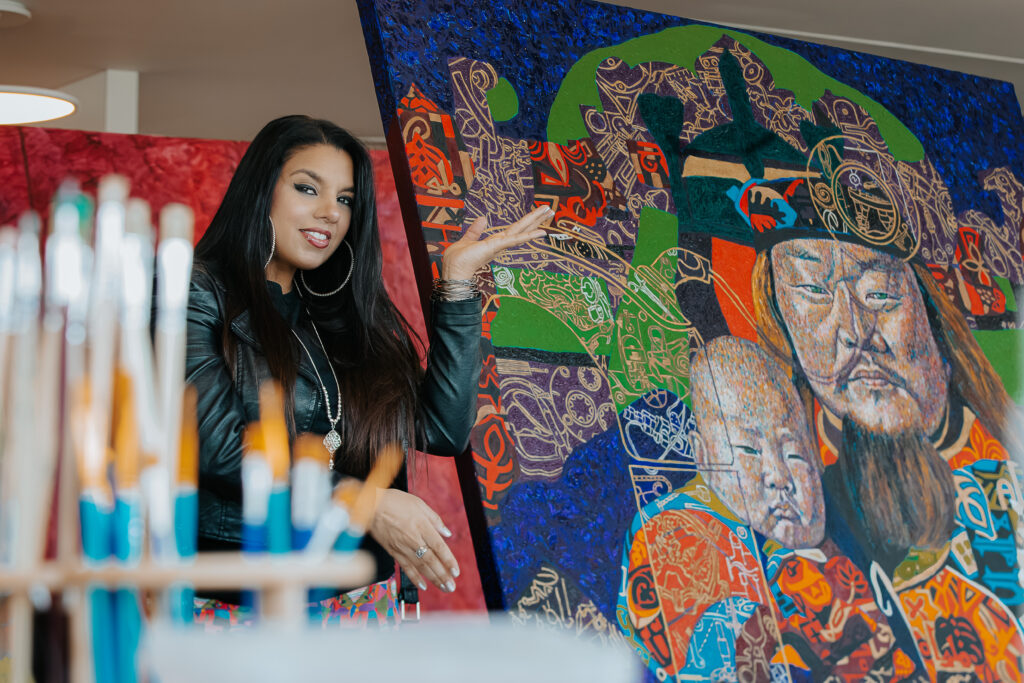
English
Amina Art Ansari: Between Colours, Cultures and Courage
In a world saturated with noise and urgency, Amina Art Ansari chooses to speak through silence.
Not an empty silence, but one brimming with life – a silence that pulses in every brushstroke, every blend of colour, and every gaze captured on her canvases. For her, art is not merely aesthetic: it is therapy, a declaration of truth and, above all, a bridge.
Born in London, to British and Pakistani heritage, Amina grew up between two cultural worlds and discovered early on that she did not need to choose just one. “I never saw differences in colour, religion, or origin. I saw people for who they were. Only later did I realise there were ‘rules’ to describe what one sees.” This raw, honest vision – shaped by a life marked by hearing loss since birth – moulded her gaze and the way she translates emotions into art.
Childhood was a time of sonic isolation, but of visual richness. Silence became a safe space where she could create, away from school and social pressures. “I paint the soul of people, consciously or unconsciously. At first, it was my escape from difficulties and the noise of the world. Over time, I realised my art is also my way of seeing and feeling life.”
This unique perspective blossomed into a career that spans continents and cultures. Amina has exhibited in galleries across the United States, Europe, and the United Arab Emirates. Her presence is also felt in art therapy workshops within vulnerable communities – from Pakistan to Leicester in the United Kingdom. “Working with different cultures and contexts taught me to see both beauty and hardship everywhere. This paints our minds and shapes our attitude towards life.”
Two of her portraits of Queen Elizabeth II and Prince Philip now form part of the Windsor Castle collection. This honour carried with it a profound sense of belonging. “It was the first time I felt fully accepted by the British – not just for my art, but for my heritage and story.” Creating these works from such widely recognised images required an additional challenge: to infuse them with a unique expression capable of going beyond photographic representation.
Until recently, Amina did not openly speak about her deafness. “People put you in a box. After the cochlear implant, it was like starting all over again.” The surgery marked a turning point. Her mother, a constant presence and source of inspiration, chose to celebrate this new phase in an unexpected way: an impromptu road trip from London to the south of France and Spain, while Amina was still recovering. “I returned from that journey to switch on the implant and hear the world for the first time. It changed how I create – I now incorporate sounds, frequencies, and even mathematics into my paintings.”
For her, a portrait goes far beyond what a camera can capture. “Photography depends on the instant. In portraiture, you are independent. Through layers of colour, strokes, and research, you create your own language and identity.” This independence is what makes her work so distinctive: combining colour psychology, cultural symbolism, and a style that moves fluidly between realism and expressionism.
Spontaneity is an essential part of her creative process. “It comes from impatience and curiosity. I research, I study, but I leave space for the unexpected. That’s how I grow and build bridges.” She believes this balance between technique and improvisation is what keeps her art alive and ever evolving.
Her story is also that of a woman navigating between cultural universes, often in opposition. “In Britain, we wait for the green light to cross the street; in Pakistan, we cross when the moment feels right, even without rules. I like to blend these worlds – and that is what I do in my art.” This ability to adapt and fuse opposites is also what allows her to connect with such diverse audiences.
When portraying figures such as humanitarian Abdul Sattar Edhi and physicist Abdus Salam, Amina felt the weight of responsibility. “There are no heroes like them today. I felt it was my duty to remind the world of their contributions – to celebrate their strength, simplicity, and impact.” For her, art has this power to reignite legacies and provoke reflection.
But her journey was not always smooth. Amina describes herself as a “tomboy” in her youth, more drawn to sports and martial arts than conventional conversations. Deafness added another layer of social isolation. “Not knowing how to network or gather information made me self-taught and independent. That can be positive or negative, but it is how I was shaped.”
Alongside her artistic career, her commitment to art therapy has only grown. Amina believes that the act of creating can transform one’s emotional and psychological state. “The world is turning upside down; our small actions matter a great deal. Less comparison, more authenticity. My imperfections are not regrets, but tools to lose and rediscover myself through art.”
Today, Amina Art Ansari continues to paint bridges between cultures, people, and inner worlds. Her work is not confined to gallery walls; it lives within personal stories, in dialogues between communities, and in every therapy session where the brush becomes a tool for healing. And above all, it is anchored in the courage to reinvent oneself.
In the end, perhaps the greatest message of her journey is this: true art is born when we find beauty in imperfection and build, stroke by stroke, a bridge between who we are and who we can become.

